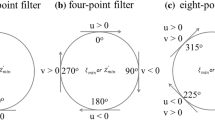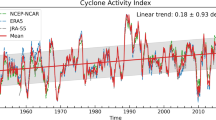Abstract
In this study, a modified identification and tracking algorithm for extratropical cyclones is developed. This identification scheme is based on triangular-mesh contouring techniques combined with a connected-component labeling method in order to detect the outer boundaries and spatial domain characteristics of individual cyclones. A new tracking method allowing for the identification of cyclone merging and splitting events, as well as short-lived windstorms, is developed to reduce the uncertainty in the tracking of extratropical cyclones. I also show that this method excludes the tracks of open systems that would have been unnecessarily detected using conventional NCP methods. The climatological features of the distribution of cyclone frequencies are substantially larger over the traditional storm track regions compared to those seen in previous studies. Interestingly, a significant increase in the cyclone density in the Arctic occurs during all four seasons (up to 19% in summer) compared to that seen with a latitude–longitude gridded mesh analysis. I develop two new regional intensity indices (depth and vorticity) based on the cyclonic domain to better quantify the cyclonic activity in the Arctic region, and find that the interannual variabilities in these two indices are highly consistent. The results of this analysis may shed light on high-latitude cyclonic behavior studies via the newly detected 2D cyclone atlas derived from this cyclonic-domain-based algorithm.
摘要
建立了对于二维气旋的自动识别与追踪算法, 有助于提高热带外地区的多中心气旋以及中尺度风暴识别的可靠性, 并揭示了北极地区的气旋活动变化与北极涛动存在密切联系.
Similar content being viewed by others
References
Armstrong, R. L., and M. J. Brodzik, 1995: An earth-gridded SSM/I data set for cryospheric studies and global change monitoring. Advances in Space Research, 16, 155–163.
Benestad, R. E., and D. Chen, 2006: The use of a calculus-based cyclone identification method for generating storm statistics. Tellus A, 58, 473–486.
Boissonat, J. D., 1984: Representing 2D and 3D shapes with the Delaunay triangulation. Proc. 7th International Conf. on Pattern Recognition (ICPR’84). Montreal, Canada. CIPPRS.
Chen, L., B. K. Tan, N. G. Kvamstø, and O. M. Johannessen, 2014: Wintertime cyclone/anticyclone activity over China and its relation to upper tropospheric jets. Tellus A, 66, 21889.
Dee, D., and Coauthors, 2011: The ERA-Interim reanalysis: Configuration and performance of the data assimilation system. Quart. J. Roy. Meteor. Soc., 137, 553–597.
Finnis, J., M. M. Holland, M. C. Serreze, and J. J. Cassano, 2007: Response of Northern Hemisphere extratropical cyclone activity and associated precipitation to climate change, as represented by the Community Climate System Model. J. Geophys. Res., 112(G4), G04S42.
Hanley, J., and R. Caballero, 2012: Objective identification and tracking of multicentre cyclones in the ERA-Interim reanalysis dataset. Quart. J. Roy. Meteor. Soc., 138, 612–625.
Hawcroft, M. K., L. C. Shaffrey, K. I. Hodges, and H. F. Dacre, 2012: How much Northern Hemisphere precipitation is associated with extratropical cyclones?. Geophys. Res. Lett., 39, L24809.
Hewson, T. D., 2009: Diminutive frontal waves–a link between fronts and cyclones. J. Atmos. Sci., 66, 116–132.
Hodges, K. I., 1994: A general method for tracking analysis and its application to meteorological data. Mon. Wea. Rev., 122, 2573–2586.
Hoskins, B. J., and K. I. Hodges, 2002: New perspectives on the Northern Hemisphere winter storm tracks. J. Atmos. Sci., 59, 1041–1061.
Hu, C., Z. Y. Guan, and M. G. Li, 2014: The seasonal cycle of redistribution of atmospheric mass between continent and ocean in the Northern Hemisphere. Science China Earth Sciences, 57, 1501–1512.
Hu, K. X., R. Y. Lu, and D. H. Wang, 2010: Seasonal climatology of cut-off lows and associated precipitation patterns over Northeast China. Meteor. Atmos. Phys., 106, 37–48.
Inatsu, M., 2009: The neighbor enclosed area tracking algorithm for extratropical wintertime cyclones. Atmospheric Science Letters, 10, 267–272.
Murray, R. J., and I. Simmonds, 1991: A numerical scheme for tracking cyclone centres from digital data. Part 2: Application to January and July general circulation models. Aust. Meteor. Mag., 39, 167–180.
Neu, U., and Coauthors, 2013: IMILAST: A community effort to intercompare extratropical cyclone detection and tracking algorithms. Bull. Amer. Meteor. Soc., 94, 529–547.
Newman, W. M., and R. F. Sproull, 1979: Principles of Interactive Computer Graphics. 2nd ed., McGraw-Hill, Inc., 541 pp.
Nielsen, J. W., and R. M. Dole, 1992: A survey of extratropical cyclone characteristics during GALE. Mon. Wea. Rev., 120, 1156–1168.
Paciorek, C. J., J. S. Risbey, V. Ventura, and R. D. Rosen, 2002: Multiple indices of Northern Hemisphere cyclone activity, winters 1949-99. J. Climate, 15, 1573–1590.
Pfahl, S., and H. Wernli, 2012: Quantifying the relevance of cyclones for precipitation extremes. J. Climate, 25, 6770–6780.
Pinto, J. G., T. Spangehl, U. Ulbrich, and P. Speth, 2005: Sensitivities of a cyclone detection and tracking algorithm: individual tracks and climatology. Meteorol. Z., 14, 823–838.
Pinto, P., and A. Silva, 2010: The strong wind event of 23rd December 2009 in the Oeste region of Portugal. Report from Instituto Português do Mar e da Atmosfera. 40 p (in Portuguese). [Available online from www.ipma.pt/resources. www/docs pontuais/ocorrencias2009/RelVentoOeste.pdf.]
Qin, Y. J., C. H. Lu, and L. P. Li, 2017: Multi-scale cyclone activity in the Changjiang River-Huaihe River valleys during spring and its relationship with rainfall anomalies. Adv. Atmos. Sci., 34(2), 246–257, doi: 10.1007/s00376-016-6042-x.
Raible, C. C., M. Yoshimori, T. F. Stocker, and C. Casty, 2007: Extreme midlatitude cyclones and their implications for precipitation and wind speed extremes in simulations of the Maunder Minimum versus present day conditions. Climate Dyn., 28, 409–423.
Rosenfeld, A., and A. C. Kak, 1976: Digital Picture Processing. Academic Press, New York.
Rudeva, I., and S. K. Gulev, 2007: Climatology of cyclone size characteristics and their changes during the cyclone life cycle. Mon. Wea. Rev., 135, 2568–2587.
Serreze, M. C., and A. P. Barrett, 2008: The summer cyclone maximum over the central Arctic Ocean. J. Climate, 21, 1048–1065.
Simmonds, I., 2000: Size changes over the life of sea level cyclones in the NCEP reanalysis. Mon. Wea. Rev., 128, 4118–4125.
Simmonds, I., and X. R. Wu, 1993: Cyclone behaviour response to changes in winter Southern Hemisphere sea-ice concentration. Quart. J. Roy. Meteor. Soc., 119, 1121–1148.
Simmonds, I., and R. J. Murray, 1999: Southern extratropical cyclone behavior in ECMWF analyses during the FROST Special Observing Periods. Wea. Forecasting, 14, 878–891.
Simmonds, I., and K. Keay, 2000: Mean Southern Hemisphere extratropical cyclone behavior in the 40-year NCEP-NCAR reanalysis. J. Climate, 13, 873–885.
Simmonds, I., and I. Rudeva, 2012: The great Arctic cyclone of August 2012. Geophys. Res. Lett., 39, L23709.
Simmonds, I., C. Burke, and K. Keay, 2008: Arctic climate change as manifest in cyclone behavior. J. Climate, 21, 5777–5796.
Sinclair, M. R., 1997: Objective identification of cyclones and their circulation intensity, and climatology. Wea. Forecasting, 12, 595–612.
Ulbrich, U., A. H. Fink, M. Klawa, and J. G. Pinto, 2001: Three extreme storms over Europe in December 1999. Weather, 56, 70–80.
Wang, X. L., V. R. Swail, and F. W. Zwiers, 2006: Climatology and changes of extratropical cyclone activity: Comparison of ERA-40 with NCEP-NCAR reanalysis for 1958–2001. J. Climate, 19, 3145–3166.
Wang, X. M., P. M. Zhai, and C. C. Wang, 2009: Variations in extratropical cyclone activity in northern East Asia. Adv. Atmos. Sci., 26, 471–479.
Wernli, H., and C. Schwierz, 2006: Surface cyclones in the ERA-40 dataset (1958-2001). Part I: Novel identification method and global climatology. J. Atmos. Sci., 63, 2486–2507, doi: 10.1175/JAS3766.1.
Whittaker, L. M., and L. H. Horn, 1984: Northern Hemisphere extratropical cyclone activity for four mid-season months. J. Climatol., 4, 297–310.
Zhang, X. D., C. H. Lu, and Z. Y. Guan, 2012a: Weakened cyclones, intensified anticyclones and recent extreme cold winter weather events in Eurasia. Environmental Research Letters, 7, 044044.
Zhang, X. D., J. E. Walsh, J. Zhang, U. S. Bhatt, and M. Ikeda, 2004: Climatology and interannual variability of arctic cyclone activity: 1948-2002. J. Climate, 17, 2300–2317.
Zhang, Y. X., Y. H. Ding, and Q. P. Li, 2012b: A climatology of extratropical cyclones over East Asia during 1958–2001. Acta Meteorologica Sinica, 26, 261–277.
Acknowledgements
This work was jointly sponsored by the National Basic Research Program of China (Grant No. 2015CB953904), the National Natural Science Foundation of China (Grant No. 41575081), the Natural Science Foundation of Jiangsu Province (Grant No. BK20161603), the Public Sector (Meteorology) Special Research Foundation (Grant No. GYHY201406024). The authors express their appreciation of the staff at ECMWF for making the reanalysis datasets freely available. I am grateful for the very constructive comments of the two reviewers.
Author information
Authors and Affiliations
Corresponding author
Electronic supplementary material
Rights and permissions
About this article
Cite this article
Lu, C. A modified algorithm for identifying and tracking extratropical cyclones. Adv. Atmos. Sci. 34, 909–924 (2017). https://doi.org/10.1007/s00376-017-6231-2
Received:
Revised:
Accepted:
Published:
Issue Date:
DOI: https://doi.org/10.1007/s00376-017-6231-2




